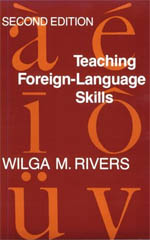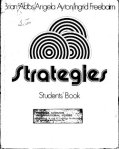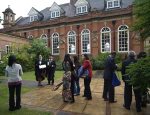 I’m working on a book chapter about methodology texts, and the name Wilga Rivers comes up again and again. You may remember that she is the first woman to get a mention in Stern’s (1983) chronology of significant language teaching milestones in the previous century (see W is for Women in ELT). Stern describes her as ‘a writer on language pedagogy who has influenced the thinking of many language teachers for nearly two decades’ (p. 107). Me included.
I’m working on a book chapter about methodology texts, and the name Wilga Rivers comes up again and again. You may remember that she is the first woman to get a mention in Stern’s (1983) chronology of significant language teaching milestones in the previous century (see W is for Women in ELT). Stern describes her as ‘a writer on language pedagogy who has influenced the thinking of many language teachers for nearly two decades’ (p. 107). Me included.
Rivers is significant from a number of points of view: she was one of the first writers on language teaching methodology to really engage with the developing field of psycholinguistics. Her first book, in fact, was called The psychologist and the foreign-language teacher (1964). But the book of hers I am most familiar with is probably also her best-known: Teaching foreign-language skills. This was first published in 1968, and then edited for re-publication in 1981. The dates are significant, if you think about it. Somewhere in that period a major sea-change had taken place in language teaching methodology, namely the advent of the communicative approach.  As Rivers herself wrote (in the second edition): ‘Much water has flown under the bridge since the sixties’ (p. xiii). What is fascinating comparing the two editions (and interesting to me for the purposes of writing my chapter) is the way that Rivers not only embraces that change but, in some ways, was able to predict it. (Even in her 1964 book she had included a chapter suggesting ways that audiolingualism could be improved.)
As Rivers herself wrote (in the second edition): ‘Much water has flown under the bridge since the sixties’ (p. xiii). What is fascinating comparing the two editions (and interesting to me for the purposes of writing my chapter) is the way that Rivers not only embraces that change but, in some ways, was able to predict it. (Even in her 1964 book she had included a chapter suggesting ways that audiolingualism could be improved.)
Her readiness to abandon the narrow strictures of the audiolingual approach and its associated structural grammar found a fuller expression in Speaking in many tongues (first published in 1972 and then revised in 1976) in which she has a chapter called ‘From linguistic competence to communicative competence’, and yet again in a subsequent book that she edited for Cambridge, Interactive language teaching (1987). This begins with an article of hers titled ‘Interaction as the key to teaching language for communication’, in which she recalls her first teacher of French when she was 11:
We performed actions; we handled objects; we drew large pictures and labelled them; we sang; we danced; we learned poems; we read little stories which we acted out and improvised upon…
And she adds: ‘Collaborative activity of this type should be the norm from the beginning of language study’ (p. 4, original emphasis).
I met Wilga Rivers only once: in Barcelona at a TESOL Spain conference in 1989. By then she would have been nearly 70. She gave a plenary, made memorable by her writing on the projector screen in indelible pen, and by her still uncompromisingly strong Australian accent. She was born in Melbourne in 1920. As Claire Kramsch (writing on the occasion of Rivers’ retirement from Harvard) recalls:
She had never intended to come to America. What she really wanted was to be the best French teacher in the Australian school system. She wanted to strengthen Australian education according to her own educational beliefs. But her Australian frontier spirit was not meant to bloom at home. It found a voice in the United States, a voice that led her to become one of the first few women full professors at Harvard, a voice now familiar to foreign language teachers all over the world . . . including Australia (1989, p. 53)
 I was teaching a Diploma course at the time of the TESOL Conference, and we were using several of Rivers’ texts, including one on motivation and another on vocabulary teaching. In the latter, she quotes the biblical line ‘A word fitly spoken is like apples of gold in settings of silver’. One of my students on the course, Catie Lenaghan, engineered a gathering with Wilga over coffee during one of the breaks: Catie had written out the quote and asked Wilga to sign it (see picture) before presenting it to me.
I was teaching a Diploma course at the time of the TESOL Conference, and we were using several of Rivers’ texts, including one on motivation and another on vocabulary teaching. In the latter, she quotes the biblical line ‘A word fitly spoken is like apples of gold in settings of silver’. One of my students on the course, Catie Lenaghan, engineered a gathering with Wilga over coffee during one of the breaks: Catie had written out the quote and asked Wilga to sign it (see picture) before presenting it to me.
Many years later, browsing in a second-hand bookshop in Boston, I was surprised to find a number of books with her (by now familiar) signature on the flyleaf (see picture below). I realized, with some sadness, that she must have recently died. Many of the books that had belonged to her dated from the pre-communicative era – books on habit formation and contrastive error analysis. Others, like the one I bought – Earl Stevick’s Images and options in the language classroom (1986) – were more recent. It was sad to see what had presumably been an extensive library broken up and dismantled like this. It makes me look at my own library with a mix of pride and foreboding.

References
Kramsch, C. J. (1989) ‘Wilga M. Rivers on her retirement.’ Modern Language Journal, 73/1.
Rivers, W. (1964) The psychologist and the foreign-language teacher. Chicago: Chicago University Press.
Rivers, W. (1976) Speaking in many tongues. (Expanded 2nd edn.) Rowley, Mass: Newbury House.
Rivers, W. (1981) Teaching foreign-language skills (2nd edn) Chicago: University of Chicago Press.
Rivers, W. (ed.) (1987) Interactive language teaching. Cambridge: Cambridge University Press.
Stern, H.H. (1983) Fundamental concepts of language teaching. Oxford: Oxford University Press.
Stevick, E. (1986) Images and options in the language classroom. Cambridge: Cambridge University Press.
 In last week’s post I identified some of the tensions that characterize the current state of ELT, the resolution of which may determine the shape that the profession takes in the next decade or two. Without daring to commit to an outcome, one way or the other, let me suggest two more dimensions along which the future of ELT may be inscribed.
In last week’s post I identified some of the tensions that characterize the current state of ELT, the resolution of which may determine the shape that the profession takes in the next decade or two. Without daring to commit to an outcome, one way or the other, let me suggest two more dimensions along which the future of ELT may be inscribed. It’s likely that this division will persist for the foreseeable future, particularly in developing countries, which do not have the means to support ongoing professional development of state-school teachers, but where the necessity of having ‘English’ somewhere on the curriculum will long outlive its utility. Meanwhile, attempts to redress the generally poor results in the public sector by introducing English-medium instruction (e.g. in the form of CLIL) will work only when both teachers and learners have a ‘critical mass’ of English language proficiency to support content-based learning without prejudicing the learning of the subject matter. In some contexts, this may still be generations away. Until then, any form of immersion is likely to be associated with the elite, private sector.
It’s likely that this division will persist for the foreseeable future, particularly in developing countries, which do not have the means to support ongoing professional development of state-school teachers, but where the necessity of having ‘English’ somewhere on the curriculum will long outlive its utility. Meanwhile, attempts to redress the generally poor results in the public sector by introducing English-medium instruction (e.g. in the form of CLIL) will work only when both teachers and learners have a ‘critical mass’ of English language proficiency to support content-based learning without prejudicing the learning of the subject matter. In some contexts, this may still be generations away. Until then, any form of immersion is likely to be associated with the elite, private sector. Either way, the effect has been to challenge, even subvert, the supremacy of the native-speaker ‘gold standard’. Will the steady penetration of English into all corners of the globe and at most levels of society, mediated by ever swifter, cheaper and more accessible technologies, do the rest? Or will the need for some mutually intelligible ‘common core’ tip the argument in favour of retaining the Queen’s English (or a version thereof)? The jury is out.
Either way, the effect has been to challenge, even subvert, the supremacy of the native-speaker ‘gold standard’. Will the steady penetration of English into all corners of the globe and at most levels of society, mediated by ever swifter, cheaper and more accessible technologies, do the rest? Or will the need for some mutually intelligible ‘common core’ tip the argument in favour of retaining the Queen’s English (or a version thereof)? The jury is out. There are not many novels whose theme is linguistics but the book I took to read on vacation is one of them. It’s called The Seventh Function of Language, and is by the French writer Laurent Binet (2015; English translation 2017). It’s a sort of whacky thriller that plays with the idea that the death of the French semiotician, linguist and literary theorist Roland Barthes (he was run over by a laundry van only hours after lunching with François Mitterand in 1980) was not an accident. It appears that Barthes had stumbled upon an as yet unidentified function of language – one so powerful that, in the wrong hands, it might wreak havoc.
There are not many novels whose theme is linguistics but the book I took to read on vacation is one of them. It’s called The Seventh Function of Language, and is by the French writer Laurent Binet (2015; English translation 2017). It’s a sort of whacky thriller that plays with the idea that the death of the French semiotician, linguist and literary theorist Roland Barthes (he was run over by a laundry van only hours after lunching with François Mitterand in 1980) was not an accident. It appears that Barthes had stumbled upon an as yet unidentified function of language – one so powerful that, in the wrong hands, it might wreak havoc. The Binet novel is a useful reminder as to how seminal a figure Jakobson was: arguably the most influential linguist of the 20th century.
The Binet novel is a useful reminder as to how seminal a figure Jakobson was: arguably the most influential linguist of the 20th century. On the other hand, the communicative approach, in seeking to redress the prevailing structural bias by substituting a syllabus of functions or tasks, may have erred in the opposite direction. Besides, as Brumfit was one of the first to point out, (1978, p. 41), a functional syllabus simply replaces one set of discrete-items with another: ‘No inventory of language items can itself capture the essence of communication.’
On the other hand, the communicative approach, in seeking to redress the prevailing structural bias by substituting a syllabus of functions or tasks, may have erred in the opposite direction. Besides, as Brumfit was one of the first to point out, (1978, p. 41), a functional syllabus simply replaces one set of discrete-items with another: ‘No inventory of language items can itself capture the essence of communication.’







Recent comments